![]()
![]()
![]()
Use LEFT and RIGHT arrow keys to navigate between flashcards;
Use UP and DOWN arrow keys to flip the card;
H to show hint;
A reads text to speech;
36 Cards in this Set
- Front
- Back
- 3rd side (hint)

|
Dome of the Rock
Jerusalem Umayyad, early islamic Octagonal building containing a giant, exposed rock. This building incorporated the 3 major religions in the area: muslim, christian, and jewish. Covered in mosaics No holy figures displayed but vine imagery Announced power of new Umayyad dynasty A site for all 3 religions Competed with Church of Holt Sepulchre |
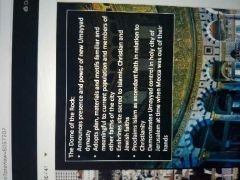
|
|

|
Great Mosque
Early Islamic Damascus Syria Umayyad Based on Muhammad house Minaret large tower for visibility. |
|
|

|
Pyxis of al-Murghira Early Islamic Ivory Umayyad |
|
|

|
Meditating Buddha South Asia From Gandhara Schist Sports mudras (hand gestures) and lakshanas (indicating superhuman) |
|
|
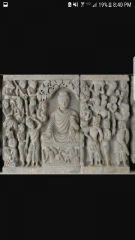
|
Life and Death Buddha South Asia From Gandhara Schist Birth, enlightenment, first sermon, death |
|
|

|
Standing Buddha (West Buddha)
South Asia Bamiyan, Afghanistan Stone, stucco, and paint
Niches in cliffface Over 100 ft tall Originally painted and covered in gems Chapels behind the figures.
|
|
|
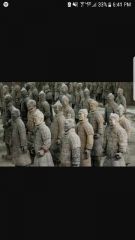
|
Warriors (or army) guarding the tomb of the First Qin Emperor
terracotta China Qin dynasty location: near Xi'an patron: Emperor Shihuangdi
Tough ruler that wanted immortality, this is a way of doing so. Labor and resources were used on this project heavily, showing the dedication to the ruler and that it was during a time of peace and stability. Each person is individualized |
|
|

|
Shakyamuni and Prabhutnaratna
gilded bronze China Northern Wei dynasty Much more stylized the original Buddhist interpretations. Skewed proportions. |
|
|
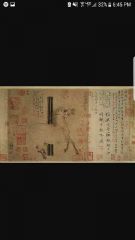
|
Han Gan Night Shining White
ink on paper China Tang dynasty Following the six laws of Chinese painting, including composition, depth, and use of color. Combination of calligraphy and pictorial representation. Red stamps are who had viewed it, showing a history and adaptation with it. Strong emotion in horse. Myth that they are disguised dragons. Monochromatic |
|
|

|
Fan Kuan Travelers Among Mountains and Streams
hanging scroll: ink and colors on silk China Northern Song dynasty Big mountains, tiny travellers. Importance of nature. Monochromatic |
|
|

|
Haniwa warrior
earthenware Japan Kofun period
Part of a series of haniwa. They varied in size and placed on top of tombs in the circular cemetery. Very stylized and simplified firgure. Costume is detailed showing military importance. Used for protection? |
|
|

|
Portrait statue of the priest Shunjobo Chogen
painted cypress wood Japan Kamakura period During civil wars. A practitioner is much more solemn than the Buddha. He is shown with age vs the idealized buddha. |
|
|

|
Night Attack on Sanjo Palace handscroll: ink and color on paper Japan Kamakura period From the Illustrated Scrolls of the Events of the Heiji Era Not meant to be read all at once, but in arm width segments. Showing the degradation of one dynasty with the abduction of emporer and son. Super expressive faces. One to one combat. |
|
|

|
Aizen Myoo, the Wisdom King of Passion
cypress wood with polychrome, gold and inlaid crystal Japan Kamakura period |
|
|
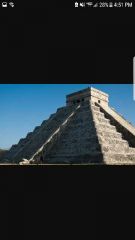
|
Temple of Kukulcan ("El Castillo")
Chichen Itza Ancient Americas Mexico [Maya] The mayan version of teotihuacan s Quetzelcotl. Encased a smaller structure. Reference to time keeping with 365 steps and direction with alignment to cardinal directions. Snake shadow during equinoxes. Activates the structure. |
|
|

|
Ball player
painted clay Ancient Americas [Maya] |
|
|

|
Running horned woman Tassili n'Ajjer Algeria Africa rock painting Therianthrope-supernatural Ceremonial markings |
|
|

|
Nok head terracotta Nok Africa Possibly part of full figure. |
|
|

|
Waist pendant of Queen Mother Idia ivory and iron Benin Africa |
|
|

|
Great Mosque Djenne Mali Africa |
|
|

|
Saint-Sernin Toulouse, France (plan and interior) Romanesque Typical church with variations. Small windows and big walls. |
|
|

|
Last Judgment attributed to Gislebertus Saint-Lazare Autun, France, limestone Romanesque Left of Christ is salvation. Right of Christ is damnation. Mandorla is full body halo. Awkward position |
|
|

|
Virgin and Child (Morgan Madonna) painted wood Romanesque |
|
|

|
Chartres Cathedral (Cathedral of Notre-Dame) Chartres, France interior, plan, west facade Gothic Pointed arches, tall, wide, distributed weight so big windows.ribbing of arches |
|
|

|
Virgin and Child (Virgin of Jeanne d'Evreux) gilded silver Gothic |
|
|

|
Giotto Lamentation Arena Chapel fresco Proto-renaissance |
|
|
|
Early Islamic |
Muhammad received revelations from God, introducing the Islamic religion. Many rulers followed him. When one successor was assassinated, a civil war broke out, resulting into Sunni and Shi'a. Located in places like Arabia, Afghanistan, Iraq, and Persia.
Art is defined by intricate mosaics and places of worship. Art was influenced by surrounding Roman and Byzantine art. |
|
|
|
South Asia |
Mainly the area of India and Nepal. Many Buddhist pieces. Depicting the Buddha |
|
|
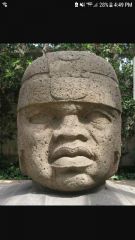
|
Olmec head (San Lorenzo Colossal Head 1)
Ancient Americas basalt [Olmec] No bodies. Head is wisdom. Part of 15. Bigger than human. Showing power of ruler. Naturalistic and round |
|
|
|
Chinese art |
Taking inspiration from Confucian and Buddhist practice, the art from China explored human relationships and ethics. Philosophy was also explored but through a nature based lense. |
|
|
|
Japanese art |
Took inspiration from the new practice of Buddhism but combined it with their existing belief of Kami dieties. Their art reflects this. They sported earthenware ceramics as well as monochromatic ink on scrolls similar to the chinese |
|
|
|
American art |
Mainly focus in central and meso America. These civilizations developed writing, astronomy, calendar systems and math.many monuments dedicated to both rulers and dieties are seen |
|
|
|
Africa |
Some of the oldest art discovered. Digital representation in painting and sculpture. Importance of rulers and ancestors. Skills in ceramics, textile, metalworking. Had functions for rituals, displays of power, or commemoration. Not a lot of written record. |
|
|
|
Romanesque |
1000 to 1200
England and normandy. Christian iconography dominated as church and state blended. Churches and cathedrals were prodominent. Ideas and styles were borrowed from Roman art, like the classic arches and vaulting |
|
|
|
Gothic |
1150 to 1450 Elaborate churches was the goal. Stained glass windows. Moved down toward France. Open spaces |
|
|
|
Proto renaissance |
Italy 1300 to 1400
Frescoes, still with Christian iconography. |
|

